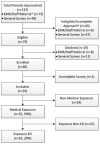Emergency Department Prescription Opioids as an Initial Exposure Preceding Addiction
- PMID: 26875061
- PMCID: PMC4958587
- DOI: 10.1016/j.annemergmed.2015.11.033
Emergency Department Prescription Opioids as an Initial Exposure Preceding Addiction
Abstract
Study objective: Opioid abuse and overdose constitute an ongoing health emergency. Many presume opioids have little potential for iatrogenic addiction when used as directed, particularly in short courses, as is typical of the emergency department (ED) setting. We preliminarily explore the possibility that initial exposure to opioids by EDs could be related to subsequent opioid misuse.
Methods: This cross-sectional study surveyed a convenience sample of patients reporting heroin or nonmedical opioid use at an urban, academic ED. We estimated the proportion whose initial exposure to opioids was a legitimate medical prescription and the proportion of those prescriptions that came from an ED. Secondary measurements included the proportion of patients receiving nonopioid substances before initial opioid exposure, the source of opioids between initial exposure and onset of regular nonmedical use, and time from initial prescription to opioid use disorder.
Results: Of 59 subjects, 35 (59%; 95% confidence interval [CI] 47% to 71%) reported they were first exposed to opioids by a legitimate medical prescription, and for 10 of 35 (29%; 95% CI 16% to 45%), the prescription came from an ED. Most medically exposed subjects (28/35; 80%; 95% CI 65% to 91%) reported nonopioid substance use or treatment for nonopioid substance use disorders preceding the initial opioid exposure. Emergency providers were a source of opioids between exposure and onset of regular nonmedical use in 11 of 35 cases (31%; 95% CI 18% to 48%). Thirty-one of the 35 medically exposed subjects reported the time of onset of nonmedical use; median time from exposure to onset of nonmedical use was 6 months for use to get high (N=25; interquartile range [IQR] 2 to 36), 12 months for regular use to get high (N=24; IQR 2 to 36), 18 months for use to avoid withdrawal (N=26; IQR 2 to 38), and 24 months for regular use to avoid withdrawal (N=27; IQR 2 to 48). Eleven subjects (36%; 95% CI 21% to 53%) began nonmedical use within 2 months, and 9 of 11 (82%; 95% CI 53% to 96%) reported nonopioid substance use or treatment for alcohol abuse before initial opioid exposure.
Conclusion: Although short-term opioid administration by emergency providers is unlikely to cause addiction by itself, ED opioid prescriptions may contribute to the development of addiction in some patients. There is an urgent need for further research to estimate long-term risks of short-course opioid therapy so that the risk of iatrogenic addiction can be appropriately balanced with the benefit of analgesia.
Copyright © 2016 American College of Emergency Physicians. Published by Elsevier Inc. All rights reserved.
Conflict of interest statement
Figures


Comment in
-
Opioids and the Emergency Physician: Ducking Between Pendulum Swings.Ann Emerg Med. 2016 Aug;68(2):209-12. doi: 10.1016/j.annemergmed.2016.01.026. Epub 2016 Mar 10. Ann Emerg Med. 2016. PMID: 26973177 No abstract available.
References
-
- Use of opioids for the treatment of chronic pain: A consensus statement from the American Academy of Pain Medicine and the American Pain Society. Clin J Pain. 1997;13(1):6–8. - PubMed
-
- Substance Abuse and Mental Health Services Administration. [May 23, 2014];The National Survey on Drug Use and Health Report: Nonmedical use of prescription-type drugs, by county type. 2013 Available at: www.samhsa.gov/data/sites/default/files/NSDUH098/NSDUH098/sr098-UrbanRur.... - PubMed
-
- Warner M, Chen LH, Makuc DM, Anderson RN, Minino AM. Drug poisoning deaths in the United States, 1980-2008. NCHS Data Brief. 2011;81:1–8. - PubMed
-
- Cicero TJ, Ellis MS, Surrat HL, Kurtz SP. The changing face of heroin use in the United States: a retrospective analysis of the past 50 years. JAMA Psychiatry. 2014;71(7):821–826. - PubMed
Publication types
MeSH terms
Substances
Grants and funding
LinkOut - more resources
Full Text Sources
Other Literature Sources
Medical

